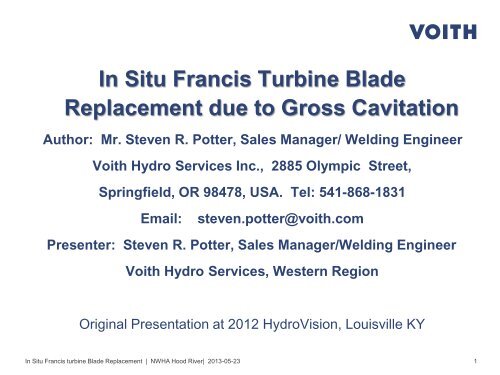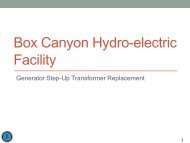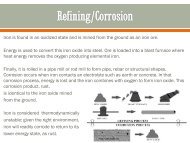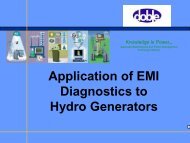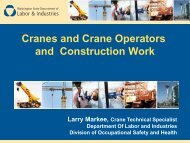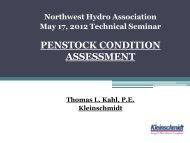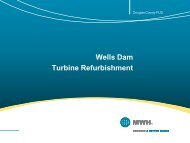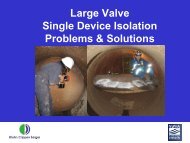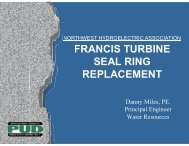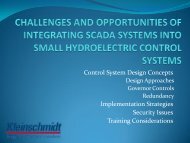In Situ Francis Turbine Blade Replacement due to Gross Cavitation
In Situ Francis Turbine Blade Replacement due to Gross Cavitation
In Situ Francis Turbine Blade Replacement due to Gross Cavitation
Create successful ePaper yourself
Turn your PDF publications into a flip-book with our unique Google optimized e-Paper software.
<strong>In</strong> <strong>Situ</strong> <strong>Francis</strong> <strong>Turbine</strong> <strong>Blade</strong><br />
<strong>Replacement</strong> <strong>due</strong> <strong>to</strong> <strong>Gross</strong> <strong>Cavitation</strong><br />
Author: Mr. Steven R. Potter, Sales Manager/ Welding Engineer<br />
Voith Hydro Services <strong>In</strong>c., 2885 Olympic Street,<br />
Springfield, OR 98478, USA. Tel: 541-868-1831<br />
Email:<br />
steven.potter@voith.com<br />
Presenter: Steven R. Potter, Sales Manager/Welding Engineer<br />
Voith Hydro Services, Western Region<br />
Original Presentation at 2012 HydroVision, Louisville KY<br />
<strong>In</strong> <strong>Situ</strong> <strong>Francis</strong> turbine <strong>Blade</strong> <strong>Replacement</strong> | NWHA Hood River| 2013-05-23<br />
1
A brief explanation!<br />
<strong>In</strong> 2011, when this project, paper and presentation were<br />
started, Peak Hydro Services was a wholly owned<br />
subsidiary of Voith Hydro <strong>In</strong>c.<br />
Today Peak Hydro Services is proudly renamed<br />
Voith Hydro Services.<br />
No longer a subsidiary company; is an integral part of<br />
Voith Hydro <strong>In</strong>c.’s After Market Business group<br />
<strong>In</strong> <strong>Situ</strong> <strong>Francis</strong> turbine <strong>Blade</strong> <strong>Replacement</strong> | NWHA Hood River| 2013-05-23<br />
2
<strong>In</strong> This Presentation<br />
• Project Facts and His<strong>to</strong>ry<br />
• Elements and Considerations of the business case<br />
• Powerhouse and Unit Description<br />
• Technical Aspects of Repair<br />
• Removal and <strong>Replacement</strong> of blades<br />
• Results and Conclusions<br />
• Acknowledgements<br />
<strong>In</strong> <strong>Situ</strong> <strong>Francis</strong> turbine <strong>Blade</strong> <strong>Replacement</strong> | NWHA Hood River| 2013-05-23<br />
3
Project Facts and His<strong>to</strong>ry<br />
• Pointe du Bois, Mani<strong>to</strong>ba, Canada – Approximately 95 miles<br />
(150 kilometers) North East of Winnipeg, Mani<strong>to</strong>ba, Canada<br />
• On the Winnipeg River<br />
• First Unit in Service: 1911<br />
• Construction Completed: 1926<br />
• Construction Cost: $3.25 Million<br />
• Station Capacity: 78 MW<br />
• Average Annual Generation: 599 kWh<br />
• Waterfall Drop: 45 feet (14 Meters)<br />
• Powerhouse Length: 440 feet (135 Meters)<br />
• <strong>Turbine</strong> Genera<strong>to</strong>rs: 15 Double horizontal shaft <strong>Francis</strong><br />
<strong>Turbine</strong> Camelback units and 1 Straflo unit<br />
• Project Acquired by Mani<strong>to</strong>ba Hydro in 2002<br />
<strong>In</strong> <strong>Situ</strong> <strong>Francis</strong> turbine <strong>Blade</strong> <strong>Replacement</strong> | NWHA Hood River| 2013-05-23<br />
4
Project Facts and His<strong>to</strong>ry<br />
• Mani<strong>to</strong>ba Hydro is the electric power and natural gas utility in<br />
the province of Mani<strong>to</strong>ba, Canada<br />
• Founded in 1961, as a provincial Crown Corporation<br />
• Operates 15 interconnected hydro generating stations<br />
• 527,000 electric power /263,000 natural gas cus<strong>to</strong>mers<br />
• Acquired Pointe du Bois in 2002; it is the oldest generating<br />
station; began operations in 1911<br />
• <strong>In</strong>itiated plans for $800 million Pointe du Bois modernization in<br />
2007<br />
• Approved <strong>to</strong> replace the 78MW powerhouse, dam and spillway<br />
with a 120-MW powerhouse<br />
• Construction projected <strong>to</strong> take six years with a planned inservice<br />
date of 2015<br />
• This plan was withdrawn in 2011<br />
<strong>In</strong> <strong>Situ</strong> <strong>Francis</strong> turbine <strong>Blade</strong> <strong>Replacement</strong> | NWHA Hood River| 2013-05-23<br />
5
<strong>In</strong> <strong>Situ</strong> <strong>Francis</strong> turbine <strong>Blade</strong> <strong>Replacement</strong> | NWHA Hood River| 2013-05-23<br />
6
Elements and Considerations of the Business Case<br />
• Fac<strong>to</strong>rs discussed are not definitive of Mani<strong>to</strong>ba Hydro’s<br />
business position - represented as some of the project<br />
considerations<br />
• With the Powerhouse replacement project cancelled – a<br />
smaller project was envisaged<br />
• Business case prepared <strong>to</strong> repair/res<strong>to</strong>re limited units<br />
• Several runners are grossly cavitated and some with partial<br />
loss of blades/band damage<br />
• Several units were shut down for safety<br />
• Some units partially disassembled and or being repaired<br />
• Refurbishment is a multiple year multiple unit project including<br />
mechanical, electrical and structural elements<br />
• The business case focused on Unit 13<br />
<strong>In</strong> <strong>Situ</strong> <strong>Francis</strong> turbine <strong>Blade</strong> <strong>Replacement</strong> | NWHA Hood River| 2013-05-23<br />
7
Elements and Considerations of the Business Case<br />
• Unit 13 is a double runner horizontal shaft <strong>Francis</strong> <strong>Turbine</strong>. The<br />
turbine casing consists of two cast iron halves<br />
• Station sees significant seasonal temperature changes which<br />
causes rise and fall of the structure and unit alignment issues<br />
• Mani<strong>to</strong>ba Hydro elected not <strong>to</strong> separate the casing on Unit 13<br />
• <strong>In</strong>itially attempted cavitation and other repairs in situ using in<br />
house employees and internal procedures<br />
• Results and progress resulted in reassessment<br />
• Decided <strong>to</strong> contract repairs <strong>to</strong> OEM’s in combination with,<br />
specialty hydro repair service providers, MH’s in house labor,<br />
engineering and project management teams<br />
• Both Unit 13 turbine runners exhibited extensive and gross<br />
cavitation<br />
• Upstream cavitation is worse (all units)<br />
• Runner bands were intact except for cavitation damage<br />
<strong>In</strong> <strong>Situ</strong> <strong>Francis</strong> turbine <strong>Blade</strong> <strong>Replacement</strong> | NWHA Hood River| 2013-05-23<br />
8
Pointe du Bois Powerhouse Cross Section<br />
<strong>In</strong> <strong>Situ</strong> <strong>Francis</strong> turbine <strong>Blade</strong> <strong>Replacement</strong> | NWHA Hood River| 2013-05-23<br />
9
Elements and Considerations of the Business Case<br />
• Voith Hydro Canada’s Mississauga Ontario division were<br />
contracted with Peak Hydro Services (then a wholly owned<br />
subsidiary of Voith Hydro), now Voith Hydro Services<br />
• Peak (Voith) Hydro Services has more than twenty seven (27)<br />
years dedicated <strong>to</strong> Hydro Field Machining and Welding<br />
Services – Voith Hydro 135 years<br />
• Concluded the downstream runner of Unit 13 was salvageable<br />
• Upstream runner was in worse condition (true of all upstream<br />
runners at the plant)<br />
• Several blades exhibited gross cavitation with multiple through<br />
holes<br />
• <strong>Cavitation</strong> so deep preparation <strong>to</strong> clean sound parent metal not<br />
possible<br />
• Determined that a minimum of three (3) blades would need <strong>to</strong><br />
be replaced<br />
<strong>In</strong> <strong>Situ</strong> <strong>Francis</strong> turbine <strong>Blade</strong> <strong>Replacement</strong> | NWHA Hood River| 2013-05-23<br />
10
Powerhouse Section and Pho<strong>to</strong>s<br />
<strong>In</strong> <strong>Situ</strong> <strong>Francis</strong> turbine <strong>Blade</strong> <strong>Replacement</strong> | NWHA Hood River| 2013-05-23<br />
11
Summary of the Business Case<br />
• Unit 13 Repair versus Replace<br />
• With significant repair work already performed, completing the<br />
runner repairs was substantially less cost than <strong>to</strong> replace<br />
• Repair lead time would be approximately half the replacement<br />
time<br />
• Return <strong>to</strong> service in approximately 14 months<br />
• ROI and time <strong>to</strong> breakeven were favorable<br />
• Successful repair would demonstrate viability of repairing other<br />
units and contribute <strong>to</strong> continuing station operations<br />
• Expected <strong>to</strong> extend unit operating life twenty (20) years<br />
<strong>In</strong> <strong>Situ</strong> <strong>Francis</strong> turbine <strong>Blade</strong> <strong>Replacement</strong> | NWHA Hood River| 2013-05-23<br />
12
Overhead view of typical unit with gates in place<br />
<strong>In</strong> <strong>Situ</strong> <strong>Francis</strong> turbine <strong>Blade</strong> <strong>Replacement</strong> | NWHA Hood River| 2013-05-23<br />
13
Typical Unit Cross Section<br />
<strong>In</strong> <strong>Situ</strong> <strong>Francis</strong> turbine <strong>Blade</strong> <strong>Replacement</strong> | NWHA Hood River| 2013-05-23<br />
14
Runner and Distribu<strong>to</strong>r Ring<br />
<strong>In</strong> <strong>Situ</strong> <strong>Francis</strong> turbine <strong>Blade</strong> <strong>Replacement</strong> | NWHA Hood River| 2013-05-23<br />
15
Technical Aspects of Repair<br />
• Unit 13 has two Horizontal <strong>Francis</strong> runners, each 99 inches<br />
diameter<br />
• Both upstream and downstream runners have thirteen (13)<br />
blades<br />
• Each blade had over its life time been repaired multiple times<br />
• Some areas of prior weld repairs were undermined (weld metal<br />
not adhering <strong>to</strong> base metal) <strong>due</strong> <strong>to</strong> improper preparation<br />
• ‘Foreign’ material (rebar) had been included as filler<br />
• All blades were severely cavitated<br />
• Major areas of cavitation on the suction side (typical) of the<br />
blades<br />
• Runner band cavitated adjacent <strong>to</strong> blade fillets<br />
• Two blades considered unrepairable, a third was marginal<br />
<strong>In</strong> <strong>Situ</strong> <strong>Francis</strong> turbine <strong>Blade</strong> <strong>Replacement</strong> | NWHA Hood River| 2013-05-23<br />
16
Typical condition of blades and band<br />
<strong>In</strong> <strong>Situ</strong> <strong>Francis</strong> turbine <strong>Blade</strong> <strong>Replacement</strong> | NWHA Hood River| 2013-05-23<br />
17
Technical Aspects of Repair<br />
• Metallurgical samples from runner crowns, bands and blades<br />
revealed chemistry similar <strong>to</strong> ASTM A27 Grade 70-36<br />
• Highly variable carbon content – classified as Medium Carbon<br />
Steel - Carbon Equivalent (CE) determines weldability<br />
• Repairs costs for in situ cavitation and blade replacements<br />
estimated <strong>to</strong> be substantially less than replacement runners<br />
• Return the unit <strong>to</strong> service one year earlier<br />
• Determined that the most cost effective and least risk repair<br />
was removal of three (3) blades by casting replacements<br />
• <strong>Blade</strong>s were 3D Laser Scanned<br />
• Data translated in<strong>to</strong> a CAD model and drawings from which<br />
blades were cast<br />
<strong>In</strong> <strong>Situ</strong> <strong>Francis</strong> turbine <strong>Blade</strong> <strong>Replacement</strong> | NWHA Hood River| 2013-05-23<br />
18
<strong>Blade</strong> prepared for Laser Scan<br />
<strong>In</strong> <strong>Situ</strong> <strong>Francis</strong> turbine <strong>Blade</strong> <strong>Replacement</strong> | NWHA Hood River| 2013-05-23<br />
19
<strong>In</strong> <strong>Situ</strong> <strong>Francis</strong> turbine <strong>Blade</strong> <strong>Replacement</strong> | NWHA Hood River| 2013-05-23<br />
20
Technical Aspects of Repair<br />
• Material and type dependent, castings are readily weldable<br />
• Casting structures of this era (1900-1920) are particularly<br />
prone <strong>to</strong> variable chemistry and are very porous<br />
• Water immersion of the components allows moisture <strong>to</strong> migrate<br />
throughout the casting filling those voids and pores<br />
• Moisture in the substrate not conducive <strong>to</strong> high quality defect<br />
free welding product<br />
• Trapped water pockets will flash <strong>to</strong> steam at exposure <strong>to</strong> the<br />
extreme temperatures of fusion welding<br />
• Gases become entrapped in the weld metal<br />
• Concern with the presence of entrapped water is the<br />
probability of hydrogen embrittlement of the material<br />
• Moisture must be removed<br />
<strong>In</strong> <strong>Situ</strong> <strong>Francis</strong> turbine <strong>Blade</strong> <strong>Replacement</strong> | NWHA Hood River| 2013-05-23<br />
21
• Under magnification the<br />
structure can in places be seen<br />
<strong>to</strong> be a loosely joined series of<br />
voids<br />
• When submerged are<br />
eventually filled with water.<br />
• The Pointe du Bois runner<br />
castings contain gas pockets,<br />
pores, voids and casting dross<br />
(impurities)<br />
<strong>In</strong> <strong>Situ</strong> <strong>Francis</strong> turbine <strong>Blade</strong> <strong>Replacement</strong> | NWHA Hood River| 2013-05-23<br />
22
Technical Aspects of Repair<br />
• Primary welding process for all areas was Flux Core Arc<br />
Welding (FCAW), a derivative process of GMAW (MIG) welding<br />
• Repairs abutting prior repair zones required special<br />
consideration as they contain surface and subsurface<br />
discontinuities<br />
• Random discontinuities found at repair margins<br />
• Selectively used Gas Tungsten Arc Welding process (GTAW)<br />
• The skills applied by the welders proved very successful<br />
eliminating defects and providing acceptable repairs<br />
• Acceptance criteria established by Voith Hydro and Mani<strong>to</strong>ba<br />
Hydro for the new repairs<br />
• <strong>In</strong> process inspections using liquid dye penetrant<br />
• Linear indications subject <strong>to</strong> Magnetic Particle <strong>In</strong>spection<br />
• All inspections were witnessed by Mani<strong>to</strong>ba Hydro<br />
<strong>In</strong> <strong>Situ</strong> <strong>Francis</strong> turbine <strong>Blade</strong> <strong>Replacement</strong> | NWHA Hood River| 2013-05-23<br />
23
Technical Aspects of Repair<br />
• <strong>Blade</strong>s measure 46” inches long by 16” wide<br />
• Thickness approximately 0.75” inches at leading and trailing<br />
edges; 1.25” at middle sections<br />
• Average repaired area 160 square inches some exceeding 250<br />
square inches<br />
• <strong>Cavitation</strong> generally exceeded 0.300” deep<br />
• Some areas greater than 1.00” deep<br />
• <strong>Blade</strong>s mapped prior <strong>to</strong> repair (as found condition)<br />
• Mapped repairs (as left condition) and pho<strong>to</strong>graphed<br />
• <strong>Blade</strong> vent openings measured before and after welding<br />
• Band gap clearance and run out was measured<br />
• Unit 13 downstream runner repaired while replacement blades<br />
for the upstream runner were being cast<br />
<strong>In</strong> <strong>Situ</strong> <strong>Francis</strong> turbine <strong>Blade</strong> <strong>Replacement</strong> | NWHA Hood River| 2013-05-23<br />
24
Typical ‘as found’ condition<br />
<strong>In</strong> <strong>Situ</strong> <strong>Francis</strong> turbine <strong>Blade</strong> <strong>Replacement</strong> | NWHA Hood River| 2013-05-23<br />
25
Typical ‘as left’ condition<br />
<strong>In</strong> <strong>Situ</strong> <strong>Francis</strong> turbine <strong>Blade</strong> <strong>Replacement</strong> | NWHA Hood River| 2013-05-23<br />
26
Removal and <strong>Replacement</strong> of blades in situ<br />
• Upstream cavitation repair before replacement blades<br />
• During repairs it was decided that one of the three (3) blades<br />
identified for replacement was actually salvageable<br />
• Substantial time, discussion and engineering was expended<br />
prior <strong>to</strong> any site work in order <strong>to</strong> plan methods <strong>to</strong> remove,<br />
replace and inspect the blades<br />
• Peak Hydro determined the best solution was using butt weld<br />
preparations as opposed <strong>to</strong> the natural fillet conjunction of<br />
band, crown and the blades in the ‘as cast’ configuration<br />
• Post weld inspection (using ultra sound) of fillets would detect<br />
anomalies inherent <strong>to</strong> the casting<br />
• Butt joints are easier <strong>to</strong> prepare for weld processing and<br />
provide a ‘cleaner’ inspection zone<br />
<strong>In</strong> <strong>Situ</strong> <strong>Francis</strong> turbine <strong>Blade</strong> <strong>Replacement</strong> | NWHA Hood River| 2013-05-23<br />
27
Prior repair at <strong>Blade</strong>/Band fillet<br />
<strong>In</strong> <strong>Situ</strong> <strong>Francis</strong> turbine <strong>Blade</strong> <strong>Replacement</strong> | NWHA Hood River| 2013-05-23<br />
28
Gouging of fillet reveals voids<br />
<strong>In</strong> <strong>Situ</strong> <strong>Francis</strong> turbine <strong>Blade</strong> <strong>Replacement</strong> | NWHA Hood River| 2013-05-23<br />
29
Removal and <strong>Replacement</strong> of blades in situ<br />
• Repair and overlay was completed in four junction zones;<br />
suction and pressure sides of fillets at band and crown<br />
• A lifting plan was prepared (safe work plan)<br />
• Each section of blade being removed/replaced weighed<br />
approximately 200 Lbs.<br />
• Chain blocks and restraining/locating plinths were welded <strong>to</strong><br />
adjacent blades <strong>to</strong> ensure that when cut free the blade would<br />
not slip out of position<br />
• <strong>Blade</strong>s were plasma cut and lowered from the 6 O’clock<br />
position<br />
<strong>In</strong> <strong>Situ</strong> <strong>Francis</strong> turbine <strong>Blade</strong> <strong>Replacement</strong> | NWHA Hood River| 2013-05-23<br />
30
<strong>Blade</strong> prepared for removal<br />
<strong>In</strong> <strong>Situ</strong> <strong>Francis</strong> turbine <strong>Blade</strong> <strong>Replacement</strong> | NWHA Hood River| 2013-05-23<br />
31
<strong>Blade</strong> fillets repaired<br />
<strong>In</strong> <strong>Situ</strong> <strong>Francis</strong> turbine <strong>Blade</strong> <strong>Replacement</strong> | NWHA Hood River| 2013-05-23<br />
32
<strong>Blade</strong> Removal and replacement<br />
<strong>In</strong> <strong>Situ</strong> <strong>Francis</strong> turbine <strong>Blade</strong> <strong>Replacement</strong> | NWHA Hood River| 2013-05-23<br />
33
<strong>Blade</strong> is lowered from runner<br />
<strong>In</strong> <strong>Situ</strong> <strong>Francis</strong> turbine <strong>Blade</strong> <strong>Replacement</strong> | NWHA Hood River| 2013-05-23<br />
34
Old/New blades compare and trim<br />
<strong>In</strong> <strong>Situ</strong> <strong>Francis</strong> turbine <strong>Blade</strong> <strong>Replacement</strong> | NWHA Hood River| 2013-05-23<br />
35
<strong>Blade</strong> removed<br />
Presentation name | place or presenter | YYYY-MM-DD<br />
36
Removal and <strong>Replacement</strong> of blades in situ<br />
• <strong>Blade</strong> stubs were prepared with a double V weld preparation<br />
geometry and inspected prior installation<br />
• The replacement blades were fitted in place and welded<br />
according <strong>to</strong> qualified sequence and weld procedures<br />
• Subjected <strong>to</strong> ultrasonic inspections by a third party inspection<br />
company<br />
• Three of four (3 of 4) welds passed 1 st inspection<br />
• One of four (1 of 4) required repair before being accepted <strong>to</strong><br />
ASME VIII standards on re-inspection<br />
<strong>In</strong> <strong>Situ</strong> <strong>Francis</strong> turbine <strong>Blade</strong> <strong>Replacement</strong> | NWHA Hood River| 2013-05-23<br />
37
Prepare stubs for replacement blade<br />
<strong>In</strong> <strong>Situ</strong> <strong>Francis</strong> turbine <strong>Blade</strong> <strong>Replacement</strong> | NWHA Hood River| 2013-05-23<br />
38
New blade being installed<br />
Presentation name | place or presenter | YYYY-MM-DD<br />
39
Ultra Sonic <strong>In</strong>spection of replacement blades<br />
<strong>In</strong> <strong>Situ</strong> <strong>Francis</strong> turbine <strong>Blade</strong> <strong>Replacement</strong> | NWHA Hood River| 2013-05-23<br />
40
Repair Results and Conclusions<br />
• Welding repairs <strong>to</strong> both downstream and upstream runners<br />
have proven very successful res<strong>to</strong>ring structure integrity, blade<br />
thickness, profile and fairness<br />
• While still a blend of old and new repairs, the surface area of<br />
quality weld material has substantially increased particularly in<br />
areas prone <strong>to</strong> cavitation<br />
• All major structural defects have been repaired<br />
• All cavitation has been removed<br />
• The removal and replacement of blades worked according <strong>to</strong><br />
planned procedure without issues<br />
<strong>In</strong> <strong>Situ</strong> <strong>Francis</strong> turbine <strong>Blade</strong> <strong>Replacement</strong> | NWHA Hood River| 2013-05-23<br />
41
Repair Results and Conclusions<br />
• Vent openings measured between each blade set<br />
• Hydraulic Balance measured as percentage from nominal<br />
• ‘As Found’ measurements not considered reliable <strong>due</strong> <strong>to</strong> the<br />
poor condition of the blade surfaces<br />
• Averaged 0.85% for the downstream and -0.36% for the<br />
upstream<br />
• ‘As Left’ measurements reveal hydraulic balance has improved<br />
<strong>to</strong> 0.08% downstream and -0.05% upstream<br />
• The two blades replaced in situ were subjected <strong>to</strong> full NDT<br />
examination in addition <strong>to</strong> dimensional checks and found <strong>to</strong> be<br />
acceptable <strong>to</strong> ASME VIII standards<br />
• Runner integrity, hydraulic balance and fairness are all<br />
substantially improved<br />
<strong>In</strong> <strong>Situ</strong> <strong>Francis</strong> turbine <strong>Blade</strong> <strong>Replacement</strong> | NWHA Hood River| 2013-05-23<br />
42
Acknowledgements:<br />
The following persons all made major contributions <strong>to</strong> the<br />
success of the Pointe du Bois project:-<br />
Mani<strong>to</strong>ba Hydro:<br />
Messrs. Jules Gareau, Jeff Marshall,<br />
Dan Nahuliak, Rejan Sayak<br />
Voith Hydro Services: Messrs. Samuel Perry, Steven Potter<br />
Chris<strong>to</strong>pher Vaughan, Michael Norris<br />
Voith Hydro Canada: Messrs. Richard Deboo,<br />
Charles Gagnon, Mehrzad Shahouei<br />
<strong>In</strong> <strong>Situ</strong> <strong>Francis</strong> turbine <strong>Blade</strong> <strong>Replacement</strong> | NWHA Hood River| 2013-05-23<br />
43
Thanks for your attention<br />
Voith Hydro Services<br />
<strong>In</strong> <strong>Situ</strong> <strong>Francis</strong> turbine <strong>Blade</strong> <strong>Replacement</strong> | NWHA Hood River| 2013-05-23<br />
44


